History
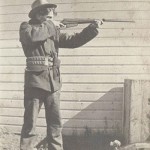
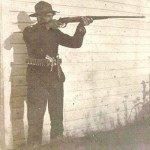 In 1910 – 1911, my Grandpa Spencer and my grandma’s brother, my Uncle Albert Schumacher, spent the winter months trapping and working in the logging camps in northern Minnesota. This was before my grandparents were married. The men took several pictures before embarking on the journey from the Schumacher farm in Elliot, North Dakota in September 1910 for their “winter in the woods”. My grandpa took his 1895 Winchester 30-03, the gun that was his pride and joy, and Uncle Albert had a 1899 Savage and they headed off on their adventure. It would be a winter to remember. It was freezing cold, often getting down to 30° below zero.
In 1910 – 1911, my Grandpa Spencer and my grandma’s brother, my Uncle Albert Schumacher, spent the winter months trapping and working in the logging camps in northern Minnesota. This was before my grandparents were married. The men took several pictures before embarking on the journey from the Schumacher farm in Elliot, North Dakota in September 1910 for their “winter in the woods”. My grandpa took his 1895 Winchester 30-03, the gun that was his pride and joy, and Uncle Albert had a 1899 Savage and they headed off on their adventure. It would be a winter to remember. It was freezing cold, often getting down to 30° below zero.
They built what they called a flat boat to carry their supplies, two rifles, two handguns, plenty of ammunition, and plenty of dried and canned food. The boat could also be loaded onto a wagon when they needed to travel across country, although, I’m not sure where they got the wagon after traveling by water. Still since I have seen the picture with the boat on the wagon, I know that they got that part covered as well. In the end, the cold winter sort of won out. They trapped during October and November and then worked in the logging camps until spring.
While the cold winter, and the freezing conditions did change their plans for the winter, you could still say that they had a successful winter of trapping anyway. Now, I don’t know how I would feel about trapping skunk, because at some point you have to go and deal with that carcass, and to me that would be horrible. We have all driven by a spot where a skunk was killed, and…whew, what a smell!! Nevertheless, my grandpa and my uncle took that in stride and came away with a good amount of skunk and muskrat pelts for their efforts. My Uncle Bill, who I must credit for the information in this story, figured that in all, 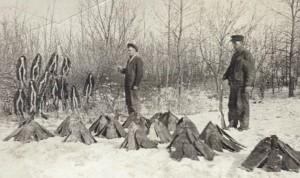
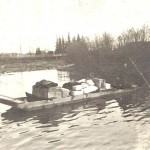 they probably made about $100.00 for that cold winter’s trapping venture, plus the money earned while working in the logging camps. It may not sound like much money for all that work and the freezing conditions, but in 1910 and 1911, it was a pretty decent wage.
they probably made about $100.00 for that cold winter’s trapping venture, plus the money earned while working in the logging camps. It may not sound like much money for all that work and the freezing conditions, but in 1910 and 1911, it was a pretty decent wage.
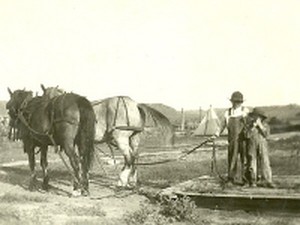 In years gone by, most farmer’s children worked on the farms of their parents. Many still do, but the way they worked has change quite a bit. Back in the old west and beyond, the fields were plowed on foot using team of horses or oxen to assist in pulling the plow through the hard ground. It has hard work, and usually resulted in the blistering of hands that were not used to it. In those days, the women didn’t usually work the farms, unless there simply was no other choice, and women with calloused hands were looked down upon and thought to be…well, not really a true lady…at least, not by Eastern standards. They just didn’t understand what it took to build the West. Many times, people moved out West with the promise of a homestead, and 5 years to prove the land. Money was scarce, and you did what you had to do…including setting your children to the task of helping out on the farm.
In years gone by, most farmer’s children worked on the farms of their parents. Many still do, but the way they worked has change quite a bit. Back in the old west and beyond, the fields were plowed on foot using team of horses or oxen to assist in pulling the plow through the hard ground. It has hard work, and usually resulted in the blistering of hands that were not used to it. In those days, the women didn’t usually work the farms, unless there simply was no other choice, and women with calloused hands were looked down upon and thought to be…well, not really a true lady…at least, not by Eastern standards. They just didn’t understand what it took to build the West. Many times, people moved out West with the promise of a homestead, and 5 years to prove the land. Money was scarce, and you did what you had to do…including setting your children to the task of helping out on the farm.
It is my opinion that the way things were done in the old West better trained the children for adulthood. I have watched so many kids go through life without having to shoulder any responsibility, and then continue on in life in the same way. Some becoming “professional students” so that they won’t have to get a job, while their parents pay their way. It’s a sad, sad situation, and one the parents find themselves having trouble getting out of.
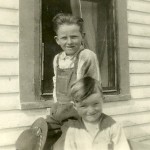
The kids in the old West understood that their help was needed or the family was not going to make it. School became a luxury and one that often ended after the eighth grade, if not before. Their time was needed elsewhere. Things have changed dramatically since then. Farm equipment has made the work on the farm much easier, and the children aren’t needed to the degree that they used to be. That is a good thing in that more kids finish school.They also have time to just be kids these days. I’m still not sure which is better…or maybe there is no better…just different.
 I have been intently watching the flooding this past week in Colorado, and especially Boulder, which is very near where my cousin Tim and his family live. Rain has poured into the state, and the flooding rivals the July 31, 1976 Big Thompson flood in many areas. In that flood, 12 to 14 inches of rain fell in 4 hours, flooding the canyon…144 people lost their lives, and 150 were injured. So far in this flood, only 4 people have died, thankfully, and hopefully that will be all, but only time will tell. Roads have been washed out, and I-25 is under water in some areas, causing it’s closure along with the closure of many other roads. Neighbors have stepped up to help save the homes of other people, some of whom they don’t even know, and often working for hours without even being asked. It has been a real show of the human spirit and its ability to care for those in need. Outside help is probably scarce, because no one can get there, leaving them somewhat isolated, except for helicopters that have been able to come in from other areas. Schools are closed, and many people have been told not to attempt to go to work. Two people were
I have been intently watching the flooding this past week in Colorado, and especially Boulder, which is very near where my cousin Tim and his family live. Rain has poured into the state, and the flooding rivals the July 31, 1976 Big Thompson flood in many areas. In that flood, 12 to 14 inches of rain fell in 4 hours, flooding the canyon…144 people lost their lives, and 150 were injured. So far in this flood, only 4 people have died, thankfully, and hopefully that will be all, but only time will tell. Roads have been washed out, and I-25 is under water in some areas, causing it’s closure along with the closure of many other roads. Neighbors have stepped up to help save the homes of other people, some of whom they don’t even know, and often working for hours without even being asked. It has been a real show of the human spirit and its ability to care for those in need. Outside help is probably scarce, because no one can get there, leaving them somewhat isolated, except for helicopters that have been able to come in from other areas. Schools are closed, and many people have been told not to attempt to go to work. Two people were 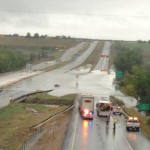 stranded in the mountains in whiteout conditions, because
stranded in the mountains in whiteout conditions, because 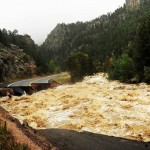 rescue resources were limited. They were rescued after 48 hours in the storm. Tim told me that the barrel they have in their back yard, to measure the rain, shows 10 inches over 3 days, with most of it coming over a 12 hour period. The huge snow storm in the mountains could cause continuing problems if it begins to melt.
rescue resources were limited. They were rescued after 48 hours in the storm. Tim told me that the barrel they have in their back yard, to measure the rain, shows 10 inches over 3 days, with most of it coming over a 12 hour period. The huge snow storm in the mountains could cause continuing problems if it begins to melt.
This flood also reminded me of an old photograph in my grandmother’s album. I’m not sure where this taken, but it does appear that they had quite a bit of water. Sadly, in those days, homes weren’t sealed as well, and so I’m sure there was extensive damage. Add to that, the fact that they didn’t have some of the clean up tools and chemicals to prevent mold, and you have a recipe for a big mess. They also didn’t have warning systems to tell them of the possiblity of a flash flood, and there were may people who lost their lives in 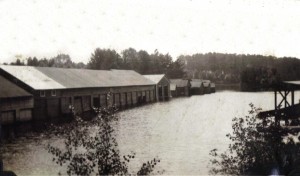 those situations. The things that have not changed over the years are the incredible human spirit and peoples’ will to survive. Neighbors will continue to help their neighbors, and people will fight to survive and rebuild their lives after each new disaster hits them. Floods are one of the most dangerous situations people can be in, and I am thankful that we have resources today to help more and more of them survive that danger. I will continue to pray for all those people who’s lives have been touched by the 2013 Colorado floods.
those situations. The things that have not changed over the years are the incredible human spirit and peoples’ will to survive. Neighbors will continue to help their neighbors, and people will fight to survive and rebuild their lives after each new disaster hits them. Floods are one of the most dangerous situations people can be in, and I am thankful that we have resources today to help more and more of them survive that danger. I will continue to pray for all those people who’s lives have been touched by the 2013 Colorado floods.
 When I picked my grandson, Josh up from Kelly Walsh High School the other day, we drove past the area where they are tearing up the old teacher’s parking lot for the school renovation project that is going on in several schools around town. Josh said, “When I look at that, it makes me sad?” He hated seeing the school he had known change. I found that a little surprising, in that this is Josh’s first year at Kelly Walsh, but when I thought about the fact that Josh’s older brother Chris has gone there for 3 years, it made sense that he would think of this school as a place he knew well. We continued down 12th Street, and past the swimming pool and he mentioned the building that was the entrance to the pool, and it really hit me.
When I picked my grandson, Josh up from Kelly Walsh High School the other day, we drove past the area where they are tearing up the old teacher’s parking lot for the school renovation project that is going on in several schools around town. Josh said, “When I look at that, it makes me sad?” He hated seeing the school he had known change. I found that a little surprising, in that this is Josh’s first year at Kelly Walsh, but when I thought about the fact that Josh’s older brother Chris has gone there for 3 years, it made sense that he would think of this school as a place he knew well. We continued down 12th Street, and past the swimming pool and he mentioned the building that was the entrance to the pool, and it really hit me.
Kelly Walsh High School has been a part of my life since I was a kid. It first opened in 1965, when I was just 9 years old. It wasn’t long after that that my sisters and I began going to Kelly Walsh High School to go swimming, almost every weekday in the summer. We walked past Pineview School to 8th Street, turned on Sally Lane, crossed the foot bridge to Forest Drive, went up to 12th Street and up to Kelly Walsh pool. It was so much fun to go swimming there every summer, and now the building is gone and the pool will follow. All those years of that pool being such a huge part of my summer…and now it will be gone.
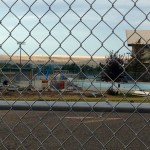
So many changes are about to occur to the school where I spent my high school years. When the work is done, I don’t know if I will even recognize it. After my graduation, my sisters attended there, and then my older sister’s older children, and then when my girls started high school it was at Kelly Walsh, and once again I spent time there. Now, two of my grandsons are there and I am spending time there again. Kelly Walsh High School will always be a part of my life it seems, but it will not always be the school it was. I know it will be a better school when they are done, and I know it is a necessary change, but it still makes me sad too.
 Twelve years ago today, our world was changed forever. In my remembrance and that of all living Americans, there has never been never been such an attack…here, on American soil…until September 11, 2001. That day will live in the memories of all the American people who were old enough to remember it, and any who have been told very much about it since. I have to wonder about the people born since that time. Will they understand what that day is all about? Or will they simply see it in the way most of us see things like the Civil War or the American Revolutionary War? Both were events that took place here in America so very long ago, fought on American soil, and yet, they seem more like a storybook event than a real event that is such a big part of our history. I don’t know how that could have been
Twelve years ago today, our world was changed forever. In my remembrance and that of all living Americans, there has never been never been such an attack…here, on American soil…until September 11, 2001. That day will live in the memories of all the American people who were old enough to remember it, and any who have been told very much about it since. I have to wonder about the people born since that time. Will they understand what that day is all about? Or will they simply see it in the way most of us see things like the Civil War or the American Revolutionary War? Both were events that took place here in America so very long ago, fought on American soil, and yet, they seem more like a storybook event than a real event that is such a big part of our history. I don’t know how that could have been 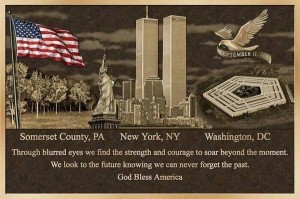 changed in the years following those wars, but with our technology, we should be able to keep the memory of the terrorist attacks in the front of our children’s thoughts, so that as they grow, we don’t lose sight of what the evil in this world can bring about.
changed in the years following those wars, but with our technology, we should be able to keep the memory of the terrorist attacks in the front of our children’s thoughts, so that as they grow, we don’t lose sight of what the evil in this world can bring about.
I did not know anyone who lost their life on 9-11, but I did know someone who could have been in the middle of that whole thing. My daughter’s friend, Carina, who has been like a third daughter to me since they were in Kindergarten, was a flight attendant during that time with Continental Airlines, based out of New Jersey. She was sick that day, and so was not flying. That did not alleviate her parents’ concerns, because they didn’t know that she was not flying and they  couldn’t get a hold of her, because she had turned her phone off. When we knew that she was safe, we all gave a sigh of relief. It is a feeling of relief that we will never forget.
couldn’t get a hold of her, because she had turned her phone off. When we knew that she was safe, we all gave a sigh of relief. It is a feeling of relief that we will never forget.
Now twelve years later we are again remembering a horrible terrorist attack against our nation, this time in Benghazi. Our government became too complacent about our safety both here and abroad, and again…people died…on a day when we should have been watchful!!! It is an atrocity!! When will we learn that we cannot forget. There is so much evil in this world and we must remain watchful, or we will be attacked again. Today, I pay tribute to those lost in all of these attacks, and to those who gave their lives trying to help others. Rest in peace.
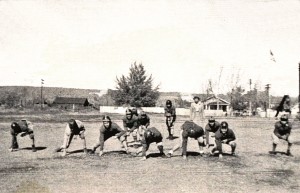 As we start football season, I recalled a picture that I had seen among my mom’s old family pictures. It was a football practice session most likely at a local school. That reminded me of something I had read a while back about the changes in football gear over the years. As we all know, football can be a dangerous game. Sometimes, the players are hurt slightly and sometimes, quite badly. Unfortunately, it was those injuries that have founded the need for better protection, and therefore, better gear. When American football appeared on college campuses in the 1870’s little was known about the brain damage that could occur from some of the impacts that are a natural part of the game.
As we start football season, I recalled a picture that I had seen among my mom’s old family pictures. It was a football practice session most likely at a local school. That reminded me of something I had read a while back about the changes in football gear over the years. As we all know, football can be a dangerous game. Sometimes, the players are hurt slightly and sometimes, quite badly. Unfortunately, it was those injuries that have founded the need for better protection, and therefore, better gear. When American football appeared on college campuses in the 1870’s little was known about the brain damage that could occur from some of the impacts that are a natural part of the game.
In those early years, head protection was rarely worn. As far back as the 1900’s, they had the “head harness” which was a soft leather version of today’s helmet, but it was mainly to protect the ears. I suppose it did, but it also made it difficult to hear, so not many players wore them. Newer versions of the helmet appeared as the years went by, featuring holes for the ears, so they could hear the plays and movement around them. They were made out of plastic, and featured a suspension system to keep the helmet from sitting directly on the player’s head. This also provided a little bit of cushion for their head. Of course, we now know that those older versions did not provide enough protection from concussion, 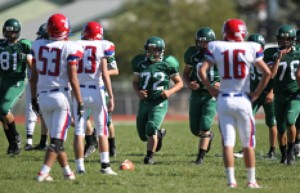 and the newer versions probably don’t do enough either, but they are much better than their predecessors.
and the newer versions probably don’t do enough either, but they are much better than their predecessors.
In the early years, players were subjected to ridicule for putting padding in all the necessary areas that we now know need protection. It was treated as…well, wimpy back then. Now plastic is a part of shoulder pads and pants. It isn’t a perfect solution, but the key here is to keep the players in the game, if possible, because we all know that one of the best things about fall is football…to some people anyway.
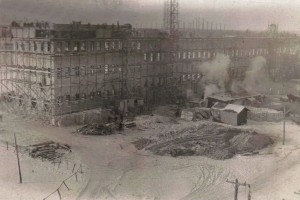 My Grandma Spencer’s photo album contains a number of pictures from the days when the family lived in International Falls, Minnesota, and worked in the lumber business, and I assume, the paper mill there in town. If the family didn’t work there, then I would assume that she was simply interested in all the changes that were taking place in the area. At that time, the big man around town was a man named Edward Backus, who owned a vast empire of lumber and paper mills. Oddly, he originally got into that business as a young college student in need of money to finish his university program. He took time off from college to earn that money, took a job in the lumber business, and bought into the business, before finally buying out his partners to become the sole owner. He later brought in a partner, William Brooks, and together they incorporated, and their company Backus-Brooks Co. bacame the parent company for for numerous subsidiaries that came into being with developments at International Falls, Fort Frances, Kenora and elsewhere. The little sawmill in Minneapolis that started it all, was
My Grandma Spencer’s photo album contains a number of pictures from the days when the family lived in International Falls, Minnesota, and worked in the lumber business, and I assume, the paper mill there in town. If the family didn’t work there, then I would assume that she was simply interested in all the changes that were taking place in the area. At that time, the big man around town was a man named Edward Backus, who owned a vast empire of lumber and paper mills. Oddly, he originally got into that business as a young college student in need of money to finish his university program. He took time off from college to earn that money, took a job in the lumber business, and bought into the business, before finally buying out his partners to become the sole owner. He later brought in a partner, William Brooks, and together they incorporated, and their company Backus-Brooks Co. bacame the parent company for for numerous subsidiaries that came into being with developments at International Falls, Fort Frances, Kenora and elsewhere. The little sawmill in Minneapolis that started it all, was 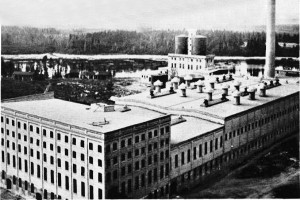 sold in 1906 because by then, the owners were devoting much of their efforts into the developing industry in the north, which is where my grandparents’ families came into the picture, and my interest was founded. As a side note, as far as I can tell, Mr Backus never went back to finish his university program, but then I suppose there wasn’t time for that with everything else that was going on in his life.
sold in 1906 because by then, the owners were devoting much of their efforts into the developing industry in the north, which is where my grandparents’ families came into the picture, and my interest was founded. As a side note, as far as I can tell, Mr Backus never went back to finish his university program, but then I suppose there wasn’t time for that with everything else that was going on in his life.
As I said, my grandmother had numerous pictures of a paper mill, in several stages of its construction. This got me started wondering if that paper mill still existed. I began my search looking for paper mills in International Falls, and came up with a current paper mill owned by Boise Cascade…a name most of us know quite well, which came back into the news just recently when they announced the layoff of 265 workers on May 2, 2013. They plan to stay open, but will focus on the successful lines of their production, and close out two unsuccessful lines. I wondered if this paper mill could have started with the one my grandmother’s pictures to me so much about.

In my research, I found not only the information on Mr Backus, but a picture of his paper mill…Falls Paper Mill…and it was indeed the one in my grandmother’s album. So, not only does the paper mill still exist, it is still in use today. So many buildings that were built in the early 1900’s are crumbling or have been demolished, but this building is still there, still standing, and still useful, although it appears that there have been some improvements and buildings added to it and around it. I guess that goes to show that good workmanship will stand the test of time.
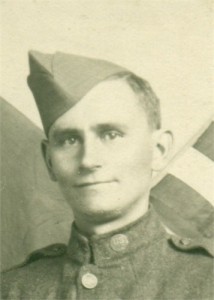 Many members of my family have fought in the many wars that have taken place in this world’s history…most of them I probably know nothing about. Wars, while usually necessary in order keep our nation secure; take a heavy toll on its youth. Of course, in years gone by, women were not placed in combat positions. That is no longer the case. Now women are among those war dead, just like men are.
Many members of my family have fought in the many wars that have taken place in this world’s history…most of them I probably know nothing about. Wars, while usually necessary in order keep our nation secure; take a heavy toll on its youth. Of course, in years gone by, women were not placed in combat positions. That is no longer the case. Now women are among those war dead, just like men are.
The weapons of warfare have become more and more deadly over the years, but I can’t say that there were more war dead because of that. War dead numbers seem to fluctuate with the war, and with the willingness to die, on the part of both sides. Sometimes however, something is invented, and then improved to save lives. Such was the case with the tank. On September 6, 1915, the tank, nicknamed Little Willie rolled off of the assembly line in England. That first tank was less than well received. It was slow…maxing out at 2 miles per hour. It weighed 14 tons, and kept getting stuck in the trenches. Nevertheless, it was important, since wars had moved into that type of fighting. Trench warfare often made soldiers sitting ducks…both the ones in the trenches, and the ones coming up on the trenches. The plan was to make a vehicle that could go cross country, and into the trenches with relative safety.
I’m sure the designers were very disappointed, but they didn’t give up. They went to work to improve this valuable piece of military equipment. The next model…Big Willie debuted a year later, and while it still needed improving, people could now see how important the vehicle would become in response to the trench warfare of World War I. The tank was in existence when my grandfather was drafted into World War I, but I don’t know if he ever had the opportunity to see one or ride in one. I can’t say if the tank changed the way that World War I was going, but it has definitely made a difference in the wars since that time.
The tank has come a long way since those days…including the name. It was never in the plan to call this piece of equipment a tank. They had planned to make a landboat, and organized a Landships Committee to begin development. It was vital that they keep the vehicle a secret from enemies, so workers were apparently told that they were building a machine to carry water on the battlefield. Some say that the tank resembled water tanks. Whatever the case may be, the new vehicles were shipped in crates labeled “tank” and the name stuck.
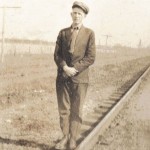 With the advent of the railroad in America back in the early 1820’s, came the fascination with trains and the railroad in general. It is a fascination that has never really ended. Even though some of our railroad tracks are now being dismantled, I don’t believe that the railroad will ever really go away. So many things are transported by rail, many of which could not feasibly be transported any other way…coal being one of the biggest industries to which the railroad is vital. My family worked in the lumber industry back in the early 1900’s, and at that time lumber and lumber products were transported by rail. There were no semi-trucks to transport things, so most things were transported to other areas of the country by rail.
With the advent of the railroad in America back in the early 1820’s, came the fascination with trains and the railroad in general. It is a fascination that has never really ended. Even though some of our railroad tracks are now being dismantled, I don’t believe that the railroad will ever really go away. So many things are transported by rail, many of which could not feasibly be transported any other way…coal being one of the biggest industries to which the railroad is vital. My family worked in the lumber industry back in the early 1900’s, and at that time lumber and lumber products were transported by rail. There were no semi-trucks to transport things, so most things were transported to other areas of the country by rail.
Early on there were huge ceremonies to celebrate the railroads entrance into a new town. 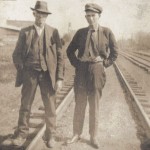 People just understood how important the railroad was to their way of life. Travel became easier, supplies and mail reached people faster, and the standard of living in the West vastly improved. It was a win win situation for everyone concerned
People just understood how important the railroad was to their way of life. Travel became easier, supplies and mail reached people faster, and the standard of living in the West vastly improved. It was a win win situation for everyone concerned
With all those changes, also came the advent of the railroad photo op. Everyone wanted their picture taken by the tracks, it seems. I have come across several pictures where the railroad tracks are the main focus of the shot. I can understand the fascination, but I was surprised by the number of people who felt the same way I did about them. Pictures weren’t as common back in the early 1900’s, although they were apparently more common than I would have thought. Still, no matter the cost, no matter how frivolous, people wanted pictures with the railroad in them. It was such a novelty, and it was a piece of history. It was their chance to prove that they were there.

Apparently, not much has changed over the decades or even the last century, because it seems to be the latest thing again, to have your picture taken on or beside the railroad tracks. Senior pictures and even family pictures are being taken there by lots of photographers, like my friend, Tammie Williamson of Williamson Creations Photography. Tammie displays railroad photographs on her photography site quite a bit. Like so many other people throughout history, she and many other people today still like the tracks for photographs. It’s just part of our fascination with the railroad, the trains, and the tracks that move them along.
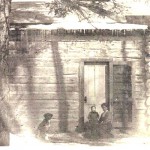 In years gone by, when it wasn’t as easy to get to your job site as it is today, many people lived as near their work as possible, especially when their work was out in the woods. Jobs in the cities and towns don’t require long drives, but when you travel on a horse, and work from sunrise to sunset; it’s nice to be close to home. Working in the logging industry, like my grandparents did, living in the woods was just part of the job.
In years gone by, when it wasn’t as easy to get to your job site as it is today, many people lived as near their work as possible, especially when their work was out in the woods. Jobs in the cities and towns don’t require long drives, but when you travel on a horse, and work from sunrise to sunset; it’s nice to be close to home. Working in the logging industry, like my grandparents did, living in the woods was just part of the job.
I’m told that their little cabin in the woods was near International Falls, Minnesota, where their daughter, my Aunt Laura was born. I would imagine that the winters were very cold there, and the best thing for anyone who could was to stay indoors, but them I seriously doubt that my grandmother was a woman who was afraid of a little but of cold and snow. Still, the cold and snow would really make it hard to work out in the woods…nevertheless, that was the job that had to be done. Maybe that was another good reason to live near your work. You could get home to the nice warm house sooner, and maybe 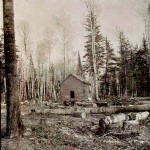 even be able to go home for lunch.
even be able to go home for lunch.
When I look at these pictures, it reminds me of the “Little House on the Prairie” books. Everywhere you look seems to be a new adventure. I can imagine how the Ingalls girls felt living there…the adventures they must have had…the adventures my Aunt Laura must have had there, playing with the children of the other logging families that lived in the woods too. I’m sure there was an abundance of forest animals to see and be in awe of. I love photographing the animals…when I happen to be in the right place at the right time. The pictures can be amazing. I can imagine all the beauty all around the little cabin in the woods.

